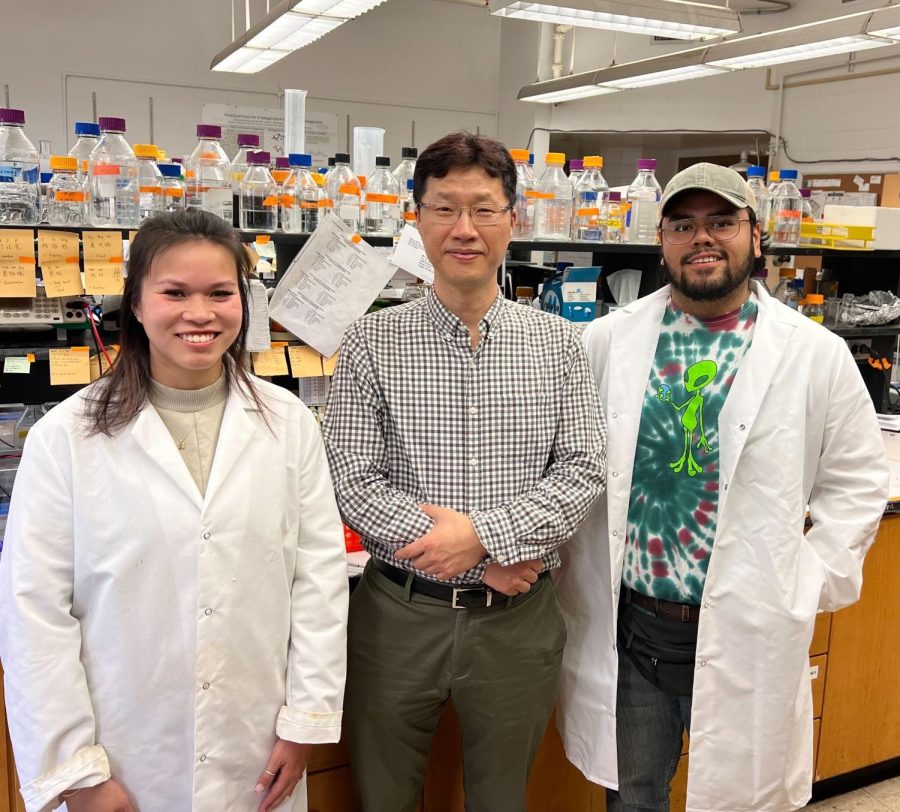UT researchers receive $1 million grant to advance skin cancer research
March 7, 2023
The Cancer Prevention and Research Institute of Texas granted UT’s Lee Lab $1 million to strengthen skin cancer research last month following breakthroughs in understanding how melanoma develops.
The lab’s research was able to pinpoint the cause of BRAF cell mutation, said Seongmin Lee, the lab’s principal investigator. BRAF cells cause cell division and reproduction, meaning cells replicate more rapidly. This mutation causes melanoma, the deadliest form of skin cancer.
In DNA, adenine bases bond with thymine bases to construct a double helix, but in a BRAF cell mutation, the bases flip, causing thymine to bond with adenine instead. The researchers hypothesize the mutation occurs when ultraviolet rays react with the two bases to form a covalent bond, Lee said. He referred to this as interstrand crosslink and believes it is triggered by solar ultraviolet radiation.
“(Other BRAF researchers) were very puzzled,” Lee said. “It’s very mysterious. This is related to solar radiation, but cannot explain this type of mutation. But our study explains the mutation.”
Lee said the team unexpectedly stumbled upon this discovery. Lab researcher Nestor Rodriguez, chemical biology and medicinal chemistry graduate student, originally discovered this mutation. He said he picked up where a former lab member, Aaron Rozelle, left off in studying several oxidants’ reactions with different variables. He took over by testing the reaction between riboflavin, a light-activated vitamin, and ultraviolet light, mimicking the sun’s effect on humans’ skin cells. This resulted in the interstrand crosslink.
“It’s cool because that’s why we have notebooks,” Rodriguez said. “You leave your research here, and anybody can come and pick it up, read it, see all your work and continue where you left off.”
Lilly Schmaltz, sixth-year graduate student and lab researcher, said she focused on the biology side of the lab. She started researching crosslinking in 2020, and plans on applying that knowledge to study crosslinking in BRAF cells specifically.
“There’s so much research out there, but there’s also so much that we don’t know,” Schmaltz said. “A lot of it is reading a lot of papers and trying to piece together the puzzle, and then figuring out where the knowledge gaps are … We’re looking at the sequence and thinking ‘hey, that’s kind of similar to this crosslinking that we do.’”
This collaborative mindset is why the Lee Lab was selected for the grant, CPRIT communication director Mark Loeffler said. It aligned with six CPRIT research priorities, including reducing the risk of cancers related to environmental carcinogens, ranging between innovative and investigator-initiated research projects and dealing with interdisciplinary or inter-institutional groups.
“You want as (much) broad-based, collaborative partnership as possible,” Loeffer said. “But it all has to start with one institution who takes the lead, and that was UT.”
Although there is no set budget plan yet, Lee said he plans on using 90% of the grant to pay the student researchers. With the increase in salary, the students can focus on research full time. Lee said he plans on attempting to renew the grant once the current three-year timeline ends.
“There are a lot of things we don’t know (about BRAF mutations),” Lee said. “We want to target BRAF replication, and our eventual goal is to treat melanoma.”












